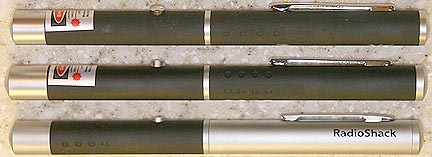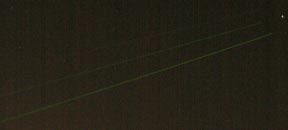This close-up shows light deflecting off dust particles
as the beam from a green laser pointer travels through air.

WAYNE SCHMIDT'S GREEN LASER POINTER PAGE (Comparing different power level lasers to see which works best.)
Introduction:
Visit any star party and you are certain to see the same scene acted out many times. Someone extends his arm and points to an object in the sky. People next to him struggle to spot the object and repeatedly fail. The problem is that because they can't sight along the arm of the person doing the directing, they see it at an angle causing an angular distortion that is all but impossible to adjust for. The director points to one star and to the observer it look like he's pointing at a completely different spot in the sky. This is a phenomenon called parallax. Fortunately, around 2004 green laser pointers became available and solved this problem.
Because the human eye is more sensitive to green than red light, there is enough light reflected off dust particles in air to make the beam from a green laser pointer visible at night.
![]()
This
close-up shows light deflecting off dust particles
as
the beam from a green laser pointer travels through air.
Since the beam is so much longer than an arm the problem of parallax isn't a problem.
By 2008 prices for green laser pointers had dropped enough so that considerably more powerful units were practical. These are attractive because their beams are longer and easier to spot. The question I wanted answered was: "How powerful a laser do you need for astronomical pointing and how do different power levels compare in the field."
Repeated Internet searches failed to turn up a single site that addressed these questions so I decided to investigate them myself. This page presents the results of my studies.
Green
Laser Comparisons:
The first thing I did was purchase three green laser pointers, each with a different power output.

From
bottom to top:
5
mw Radio Shack pointer, $50
20
mw MPO pointer from HDE through Amazon.com, $23
50
mw MPO pointer from HDE through Amazon.com, $55
Excepting minor cosmetic differences, the basic construction of each is so similar that I wouldn't be surprised to learn that most are made by a single manufacturer and simply repackaged to suit particular retailers.
Conditions have an enormous affect on how bright the beam appears. In daylight even the most powerful is invisible. Under dark skies beam brightness varies in direct relation to its power. Dusty or foggy conditions cause more light to be deflected from the beam making it brighter, but at the cost of reducing how long it appears.
For my tests I decided the most likely place such a pointer would be used would be at a public star party, in town, such as those hosted by libraries or museums. More serious star parties, those located far from cities in dark sky locations, are most likely attended by experienced astronomers who know the night sky so well that laser pointers wouldn't be all that useful. (In as much as an accidental reflection off a tree or similar obstacle could spoil everyone's night vision for several minutes, using a green laser pointer at a more serious star party may not only be impolite but as prohibited as white-light flashlights.)
The test location I chose was in the middle of a town with a population of 130,000. Light population was bad enough so that the only star visible in Ursa Minor, the Little Dipper, was Polaris. The following image accurately captures what the beams from the three different pointers looked like when viewed one foot to the side of the pointers, in other words: looking almost along the length of the beams.

From
top to bottom: 5mw beam, 20mw beam and 50mw beam
The white dot near the end of the middle beam is Polaris.
While advertisers routinely claim that the beams from their pointers appear to go on forever, comparison to trees of known distances from the pointers disclosed that the 5mw beam had an effective length of 80 feet, the 20mw beam 120 feet and the 50mw beam 140 feet. For pointing purposes they all worked equally well.
Things change quickly as the viewers move farther away from the pointers. The image below shows how the beams dimmed when seen ten feet off to one side:

The 5 mw beam was all but invisible and the 20mw beam difficult to track. The 50 mw was still comparatively bright and easy to follow. At twenty feet from the pointers only the 50mw beam was visible and even it was difficult to spot.
The problem is that the beams are like a string of Christmas lights. Look down their length and the string appears bright because each bulb adds to its overall brilliance. But, move far off to one side and the same amount of light is stretched out over a much greater distance, making the string appear dimmer per unit of length. Since the laser beams are made visible by a line of reflections off dust particles the same phenomenon occurs.
Conclusion:
Only the 50mw green laser pointer provided a bright enough beam to be followed easily to the intended target by any reasonably-sized group of people. Even then, It's best to have them gathered as close as possible to the person handling the pointer.
Cost
Considerations:
Prices vary enormously for any particular power level. Five milliwatt pointers, the most common, can be found for as little as $7 or as much as $99. Making things even more confusing price-wise is that they fluctuate significantly over time. Two weeks after I purchased the 50 mw pointer from Amazon its price dropped from $55 to $42. Over the same period the 20 mw unit increased from $23 to $27.
I found astronomy catalogs to be the highest priced sources for green laser pointers and for the most part only sold the low 5mw devices.
Reliability:
An important issue with high power pointers is reliability. I was fortunate to exchange several emails and a telephone call with Mr. David Rifkin, President and CEO of MPO, a major laser pointer source. He explained that many of the cheap, high power pointers on the market are actually lower power units being overdriven to produce brighter beams. The downside of this is that the laser diode lifetime is reduced from thousands of hours to perhaps as few as a hundred. Additionally, many such units exhibit erratic power fluctuations and sudden breakdowns.
My experiences with the 20 and 50 mw pointers confirmed Mr. Rifkin's comments. The 20 mw pointer exhibits a half-second delay in its brightness. It comes on initially at 5 mw then snaps on to full power. The 50 mw pointer needs to be thoroughly warmed up before it puts out full power. This can take up to four minutes from room temperature. Under very cold conditions the pointer may be completely dissabled. (I protect mine by keeping it as close to my skin as possible to keep it warm until needed.)
Erratic behavior isn't limited to high-power pointers. I purchased a second 5 mw unit and discovered that it started off very bright, then within seconds began flickering and dimming until after four minutes it was barely half as bright as the Radio Shack pointer. This pointer came from a dealer who promised it had been factory tested and tuned.
Cheap units, such as the greatly discounted pointers available from Amazon.com, have extremely poor reliabilities as evidenced from the number of negative reviews posted about them on their individual product pages. The ratings for the 50mw unit I purchased were almost 50-percent negative with some comments stating that it broke down after just minutes of use.
Clearly, purchasing such pointers is a risky endeavor.
An
Important Warning:
I was surprised to learn how easy it is to purchase high power lasers on the Internet. These devices pack enough power to easily blind someone so if you decide to buy one, please be careful where the beam's pointed. Not only watch out for the beam directly hitting someone in the eye but also reflecting off mirrors, chrome, or even transparent glass. Such beams can still have enough power to injure.
Some consideration should also be given to astrophotographers. With the high sensitivity of modern astro cameras it's possible to ruin an hour's exposure by carelessly sweeping the beam from a high powered green laser pointer across the camera's field of view.
Green
Laser Pointers for Lectures:
Red laser pointers have dominated presentation venues for years. Then around 2007 green laser pointers became available at increasingly low prices.

Green pointers' brighter spots and novel color are making them the rage.
Because they come in high-power versions there's a slight one-upsmanship competition going on between presenters to determine who can impress audiences more. The question this article addresses is: What power level is optimum? Too little and in brightly lit presentation halls the spot may be lost or appear weak, reflecting poorly on the presenter. To much power and the area immediately surrounding the spot can be washed out. To examine these issues I purchased 5mw, 20 mw and 50 mw pointers and compared them under typical presentation condition: subdued room lighting and pointing the beam at a bright surface such as the screen for a transparency projector.

Left
to right: 5mw, 20mw and 50mw spots
The spot sizes above are from beams projecting on a screen 40 feet away. While the 50 mw spot is the largest, to audiences all of the pointers produce spots that are so small as to appear as points. However, the brilliance of the spots varies much more than the photograph above portrays. The 50 mw pointer is so bright that it's almost painful to look at.
I found that the 5 mw pointer is bright enough for almost any presentation venue. The only time it will be challenged is outside with direct sunlight shining on the presentation surface. The 20 mw unit provides more "pop" and shows up well under even those conditions. The 50 mw unit is too bright for indoor use. The spot overpowers the area immediately around it and in small rooms will leave viewers wincing from its brilliance. Worse still, the beam is bright enough to be seen traveling through the air. This light-saber effect may be entertaining and useful at star parties for pointing out objects in the night sky, but in a presentation room it can be distracting.
My recommendation is to stick with 5 mw pointers purchased from a store where you can test it before purchasing. Hold it on for several minutes to make sure the beam output remains constant. Store-bought pointers will be more expensive than bargains on the Internet but in exchange you know you are getting something that works.
(Click
on main site
to browse 70 other topics ranging from exotic kaleidoscope designs to
the strange world of lucid dreaming. There you will also find several
other pages dealing with chocolate.)